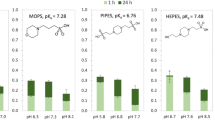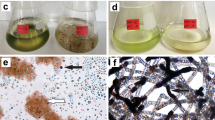Abstract
The significance of freshwater systems in global manganese cycles is well appreciated. Yet, the polar systems, which encompass the largest freshwater repository in the world, have been least studied for their role in manganese cycling. Here, we present results from a study that was conducted in the brackish water lakes in the Larsemann Hills region (east Antarctica). The rate of in situ manganese oxidation ranged from 0.04 to 3.96 ppb day−1. These lakes harbor numerous manganese-oxidizing bacteria (105 to 106 CFU l−1), predominantly belonging to genera Shewanella, Pseudomonas and an unclassified genus in the family Oxalobacteriaceae. Experiments were conducted with representatives of predominant genera to understand their contribution to Mn cycling and also to assess their metabolic capabilities in the presence of this metal. In general, the total and respiring cell counts were stimulated to a maximum when the growth medium was amended with 10 mM manganese. The addition of manganese promoted the use of d-mannitol, maltose, etc., but inhibited the use of maltotriose, l-serine and glycyl l-glutamic acid. The bacterial isolates were able to catalyze both the redox reactions in manganese cycling. In vitro manganese oxidation rates ranged from 3 to 147 ppb day−1, while manganese reduction rates ranged from 35 to 213 ppb day−1. It was also observed that the maximum stimulation of manganese oxidation occurred in the presence of cobalt (81 ± 57 ppb day−1), rather than iron (37 ± 16 ppb day−1) and nickel (40 ± 47 ppb day−1). Our studies suggest that cobalt could have a more profound role in manganese oxidation, while nickel promoted manganese reduction in polar aquatic systems.








Similar content being viewed by others
References
Beijerinck MW (1913) Oxydation des Mangancarbonates durch Bakterien und Schimmel-pilze. Fol Mikrobiol Holland Beitr Gesamt Mikrobiol Delft 2:123–134
Bowen HJM (1979) Environmental chemistry of elements. Academic, London
Bratina BJ, Green WJ, Schmidt TM (1998) Microbially mediated transformations of manganese in Lake Vanda. Antarct J US 31:213–214
Burgess JS, Kaup E (1997) Some aspects of human impact on lakes in the Larsemann Hills, Princess Elizabeth Land, Eastern Antarctica. In: Lyons WB, Howard-Williams C, Hawes I (eds) Ecosystem processes in Antarctic ice-free landscapes. Balkema, Rotterdam, pp 259–264
Burgess JS, Gillieson D, Spate AP (1988) On the thermal stratification of freshwater lakes in the snowy mountains, Australia, and the Larsemann Hills, Antarctica. Search 19:147–149
Canfield DE, Green WJ, Nixon P (1995) 210Pb and stable lead through the redox transition zone of an Antarctic lake. Geochim Cosmochim Acta 59:2459–2468
Crerar DA, Barnes HL (1974) Deposition of deep-sea manganese nodules. Geochim Cosmochim Acta 38:279–300
Davison W, Woof C, Rigg E (1982) The dynamics of iron and manganese in a seasonally anoxic lake: direct measurement of fluxes using sediment traps. Limnol Oceanogr 27:987–1003
Diem D, Stumm W (1984) Is dissolved Mn2+ being oxidized by O2 in absence of Mn-bacteria or surface catalysts? Geochim Cosmochim Acta 48:1571–1573
Ehrlich HL (1996) Geomicrobiology. Dekker, New York
Ehrlich HL (1999) Microbes as geologic agents: their role in mineral formation. Geomicrobiol J 16:135–153
Fernandes SO, Krishnan KP, Khedekar VD, Loka Bharathi PA (2005) Manganese oxidation by bacterial isolates from the Indian Ridge System. Biometals 18:483–492
Garland JL, Mills AL (1994) A community-level physiological approach for studying microbial communities. In: Ritz K, Dighton J, Giller KE (eds) Beyond the biomass: composition and functional analysis of soil microbial communities. Wiley, Chichester, pp 334–336
Gasparon M, Burgess JS (2000) Human impacts in Antarctica: trace element geochemistry of freshwater lakes in the Larsemann Hills, East Antarctica. Environ Geol 39:963–976
Gasparon M, Matschullat J (2006) Geogenic sources and sinks of trace metals in the Larsemann Hills, East Antarctica: natural processes and human impact. Appl Geochem 21:318–334
Gasparon M, Lanyon R, Burgess JS et al (2002) The freshwater lakes of the Larsemann Hills, East Antarctica: chemical characteristics of the water column. ANARE Report No. 147, Kingston, Tasmania
Gillieson D, Burgess JS, Spate A et al (1990) An atlas of the lakes of the Larsemann Hills, Princess Elizabeth Land, Antarctica. ANARE Research Notes No. 74, Kingston, Tasmania
Gillieson DS (1991) An environmental history of two freshwater lakes in the Larsemann Hills, Antarctica. Hydrobiologia 214:321–331
Green WJ, Ferdelman TG, Gardner TJ et al (1986a) The residence times of eight trace metals in a closed-basin Antarctic Lake: Lake Hoare. Hydrobiologia 134:249–255
Green WJ, Canfield DE, Lee GF et al (1986b) Mn, Fe, Cu, and Cd distributions and residence times in closed-basin Lake Vanda (Wright Valley, Antarctica). Hydrobiologia 134:237–248
Hicks RE, Amann RI, Stahl DA (1992) Dual staining of natural bacterioplankton with 4′, 6-diamidino-2-phenylindole and fluorescent oligo nucleotide probes targeting kingdom-level 16S rRNA sequences. Appl Environ Microbiol 58:2158–2163
Hobbie JE, Daley RJ, Jasper S (1977) Use of nuclepore filters for counting bacteria by fluorescence microscopy. Appl Environ Microbiol 33:1225–1228
Hulth S, Aller RC, Gilbert F (1999) Coupled anoxic nitrification/ manganese reduction in marine sediments. Geochim Cosmochim Acta 63:49–96
Jackson DD (1901a) A new species of Crenothrix (C. manganifera). Trans Am Microsc Soc 23:31–39
Jackson DD (1901b) The precipitation of iron, manganese and aluminium by bacterial action. J Soc Chem Ind 21:681–684
Klimov VV (1984) Charge separation in photosystem II reaction centers: The role of pheophytin and manganese. In: Sysbesina C (ed) Advances in photosynthetic research, vol 1, proceedings of the sixth international congress on photosynthesis. Nijhoff, The Hague, pp 131–138
Knief C, Altendorf K, Lipski A (2003) Linking autotrophic activity in environmental samples with specific bacterial taxa by detection of 13C-labelled fatty acids. Environ Microbiol 5:1155–1167
Konhauser KO, Pecoits E, Lalonde SV et al (2009) Oceanic nickel depletion and a methanogen famine before the great oxidation event. Nature 458:750–753
Lenhard G (1956) The dehydrogenase activity in soil as a measure of the activity of soil microorganisms. Z Pflanzenernaehr Dueng Bodenkd 73:1–11
Lieske R (1919) Zur Ernahrungsphysiologie der Eisenbakterien. Zentralbl Bakteriol Parasitenk Infektionskr Hyg Abt II 49:413–425
Louws FJ, Schneider M, deBruijn FJ (1996) Assessing genetic diversity of microbes using repetitive sequence-based PCR (rep-PCR). In: Toronzos G (ed) Nucleic acid amplification methods for the analysis of environmental samples. Technomic Publishing Co, Inc, Lancaster, pp 63–93
Luther GWIII, Sunby B, Lewis BL et al (1997) Interactions of manganese with the nitrogen cycle: alternative pathways to dinitrogen. Geochim Cosmochim Acta 61:4043–4052
Mulder GE (1972) Le cycle biologique tellurique et aquatique du fer et du manganese. Rev Ecol Biol Sol 9:321–348
Okazaki M, Sugita T, Shimizu M et al (1997) Partial purification and characterization of manganese-oxidizing factors of Pseudomonas fluorescens GB-1. Appl Environ Microbiol 63:4793–4799
Rosson RA, Nealson KH (1982) Manganese binding and oxidation by spores of marine bacillus. J Bacteriol 151:1027–1034
Sartory A, Meyer J (1947) Contribution a letude du metabolisme hydrcarbone des bacteries ferrugineuses. CR Acad Sci (Paris) 225:541–542
Sasser M (1990) Identification of bacteria through fatty acid analysis. In: Klement Z, Rudolph K, Sands D (eds) Methods in phytobacteriology. Akadémiai Kiadó, Budapest, pp 199–204
Schat JA, Green WJ, Decarl EF et al (2004) The geochemistry of Lake Joyce, McMurdo Dry Valleys, Antarctica. Aquat Geochem 10:325–352
Schweisfurth R, Eleftherladis D, Glaslach II (1978) Microbiology of the precipitation of manganese. In: Krumbien WE et al (eds) Environmental biogeochemistry and geomicrobiology, vol 3. Ann Arbor Science, Ann Arbor, pp 923–928
Sinensky M (1974) Homeoviscous adaptation: a homeostatic process that regulates the viscosity of membrane lipids in Escherichia coli. Proc Natl Acad Sci USA 71:522–525
Sokolova-Dubinina GA, Deryugina ZP (1967a) On the role of microorganisms in the formation of rhodochrosite in Punnus-Yarvi Lake. Mikrobiologiya 36:535–542
Sokolova-Dubinina GA, Deryugina ZP (1967b) Process of iron–manganese concretion formation in Lake Punnus-Yarvi. Mikrobiologiya 36:1066–1076
Tebo BM, Johnson HA, McCarthy JK et al (2005) Geomicrobiology of manganese (II) oxidation. Trends Microbiol 13:421–428
Tipping E, Thompson DW, Davidson W (1984) Oxidation products of Mn(II) oxidation in lake waters. Chem Geol 44:359–383
Tipping E, Jones JG, Woof C (1985) Lacustrine manganese oxides: Mn oxidation states and relationships to “Mn depositing bacteria”. Arch Hydrobiol 105:161–175
Acknowledgments
This work was supported by grants from the Ministry of Earth Sciences, Government of India. We are thankful to Shri Rasik Ravindra, Director, NCAOR for his interest in this study. Our sincere thanks are due to Dr Thamban Meloth and Mr Prashant Redkar (Ice Core Laboratory) for carrying out the ICP analysis, which was extremely crucial for this work and to Dr Rahul Mohan for helping with the SEM–EDS analysis. We record our gratefulness to Prof. Henry L. Ehrlich, Prof. Manfred Bölter and the two anonymous reviewers who critically reviewed the manuscript and helped us to improve the contents. This is NCAOR contribution no. R-49.
Author information
Authors and Affiliations
Corresponding author
Rights and permissions
About this article
Cite this article
Krishnan, K.P., Sinha, R.K., Krishna, K. et al. Microbially mediated redox transformations of manganese (II) along with some other trace elements: a study from Antarctic lakes. Polar Biol 32, 1765–1778 (2009). https://doi.org/10.1007/s00300-009-0676-4
Received:
Revised:
Accepted:
Published:
Issue Date:
DOI: https://doi.org/10.1007/s00300-009-0676-4




